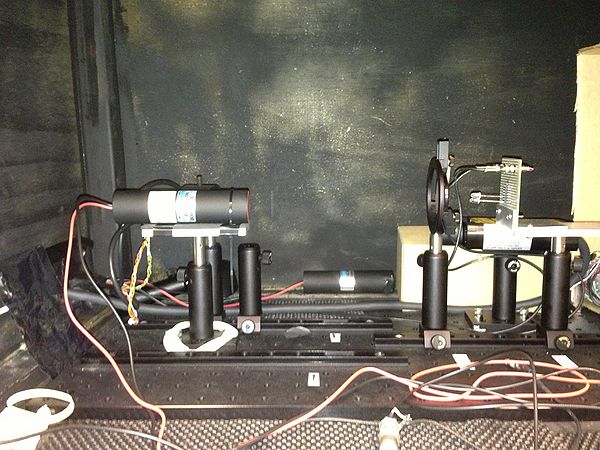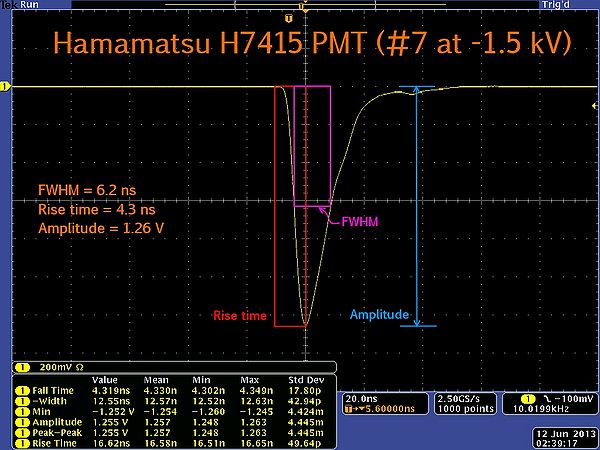Construction of Low-Granularity counters
Contents
PMT Testing
Expectations
The photomultiplier tubes (i.e. 18 in all) should, in principle, all exhibit the same characteristics. All 18 should have the same change in output amplitude with a change in input potential, as well as identical time responses regardless of the input potential. Therefore, one would expect a histogram of these characteristics to show a count of 18 at a single value on the x-axis. Consequently, a logarithmic plot of the overall gains of each PMT should be 18 identical lines of positive slope.
The Hamamatsu Photomultiplier Tube (H7415) was chosen because it has the characteristics required for this pair spectrometer. This PMT will be attached to the EJ-200 organic plastic scintillator and light guide fabricated by Eljen Technology. The properties of the tube are in the table below:
| Photomultiplier Tube Assembly (H7415) | |
| Dynode Structure | Linear-focused |
| Dynode Stages | 10 |
| Max. Rating) Anode to Cathode Voltage | -2000 V |
| Anode to Cathode Supply Voltage | -1500 V |
| Anode) Gain Typ. | 5E+06 |
| (Time Response) Rise Time Typ. | 1.7 ns |
| (Time Response) Transit Time Typ. | 16 ns |
Rise time listed here was arrived at using a laser. In the testing of the PMT's at Jefferson Lab, an LED will be used, which will not produce a clean signal elimination like the laser.
Testing
To test the PMT's, connections had to be soldered on to the wires in order to have quick connection ability to both the oscilloscope and high-voltage power source. Once this was done, the PMT was placed in a previously fabricated dark box with mounts for the tube and LED. The LED was powered by a wave generator which was set to run 8V square waves at 10 kHz with a 8 ns pulse width. Figure 1 shows the set up used for each PMT.
The LED was positioned behind a diffracted lens to spread the light out. Careful attention had to be made that each PMT was positioned at the same place on the mount in order to eliminate fluctuations in beam intensity. The anode-to-cathode potential would range from -1.1 kV to -1.5 kV.
Data
The data gathered from the oscilloscope were the amplitude and rise time. Figure 2 shows what those values represent on the oscilloscope screen. Amplitudes were measured in millivolts and the rise time was in nanoseconds.
The data for the PMT amplitudes is in the table below. At -1.1 kV, the minimum amplitude was 124 mV. At -1.5 kV, the maximum amplitude was 1660 mV.
| PMT Amplitudes (mV) | ||||||
|---|---|---|---|---|---|---|
| PMT # | -1.1 kV | -1.2 kV | -1.3 kV | -1.4 kV | -1.5 kV | |
| 1 | 171 | 303 | 513 | 833 | 1320 | |
| 2 | 124 | 219 | 365 | 583 | 906 | |
| 3 | 187 | 330 | 553 | 892 | 1400 | |
| 4 | 213 | 376 | 627 | 1010 | 1575 | |
| 5 | 216 | 387 | 657 | 1060 | 1670 | |
| 6 | 178 | 313 | 522 | 839 | 1310 | |
| 7 | 171 | 302 | 507 | 812 | 1256 | |
| 8 | 181 | 322 | 542 | 877 | 1380 | |
| 9 | 159 | 284 | 473 | 755 | 1160 | |
| 10 | 168 | 299 | 504 | 811 | 1260 | |
| 11 | 160 | 289 | 489 | 785 | 1236 | |
| 12 | 210 | 370 | 624 | 1000 | 1556 | |
| 13 | 214 | 385 | 650 | 1050 | 1660 | |
| 14 | 203 | 359 | 600 | 968 | 1500 | |
| 15 | 159 | 287 | 483 | 780 | 1215 | |
| 16 | 170 | 299 | 504 | 810 | 1300 | |
| 17 | 195 | 348 | 607 | 970 | 1500 | |
| 18 | 216 | 376 | 627 | 997 | 1550 | |

